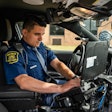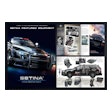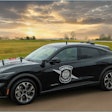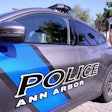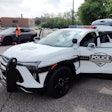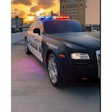They may seem like big, expensive hunks of metal on wheels, but many agencies have come to realize that mobile command vehicles offer many advantages for the cost.
Mobile command units are big expenditures, but they are well worth it to departments that have purchased them. One vehicle can act as a base of operations for a critical incident or as a means of crowd control for a local parade. It can also be used in high-crime areas to coordinate operations or even as a mobile substation. Both of these applications can help bring a strong police presence into a community.
While it isn’t hard to find ways to use a mobile command unit, justifying the use of such an expensive police resource can be tricky.
Funding
Funding is a different issue for every agency. Some larger agencies have mobile command units built into their vehicle replacement plans along with squad cars and motorcycles, while other departments have used separate funding for their specialty vehicles. (For more on vehicle replacement plans, see “How to Purchase Patrol Cars,” July 2003.)
The Thurston County (Wash.) Sheriff’s Office had to give up some of the cars it had planned to purchase when it decided to buy a mobile command unit from Braun Northwest. The decision was seen as a benefit in the long run. But sometimes it’s hard to convince the rest of a department that a specialty vehicle is as vital a need as new patrol cars.
Thurston County’s Det. Ron Hansen says the first hurdle was conducting an objective needs assessment and deciding what his department really needed in a vehicle. Then he scheduled a meeting with county officials. “We had a working meeting to educate them as to what spec ops does and what’s needed to do that job effectively,” he says.
In contrast, the Los Angeles Police Department didn’t have to sacrifice any patrol cars when its SWAT team needed a new vehicle. The department had a certain amount of money set aside specifically for a mobile command unit. In fact, since the department ended up deciding on a less expensive model than it had in its original plans, the team was able to outfit the vehicle with more equipment for the same amount of money.
And for the Dallas-Fort Worth Airport, a mobile command unit was considered a separate capital expenditure that needed to be approved. But since it was seen as a necessary piece of equipment, the approval process went rather smoothly, once everyone was convinced.
Research
Regardless of funding, buying vehicles this expensive is a long and complex process. Just conducting in-depth research on companies, chassis, layouts, and equipment can take a great deal of time.
“We probably spent six months researching this,” says LAPD’s Officer Ted Reyland. And the department already had many command vehicles in use, so the process was nothing new.
Perhaps the delay was caused by the fact that instead of buying or refurbishing a tractor-pulled trailer, LAPD SWAT decided to acquire a fully mobile unit from Mattman Specialty Vehicles that would be more able to get into tight spots, more quickly.
LAPD’s process was a cakewalk compared to the experience of the Dallas-Fort Worth (DFW) Airport police and fire departments. These agencies spent five years trying to get a mobile command unit to share.
What broke the logjam was 9/11.
Larry LaGuardia, director of the Special Services Vehicle Division at LDV, says many departments and communities are willing to put out the money for what is now seen as a necessity, not a luxury.
No matter the situation, contacting other agencies about their mobile command units is an important step in deciding what will best work for your department.
Reyland says the LAPD spent time talking to other departments about their mobile command vehicles and even walked through the units to see what ideas they could borrow. “We asked: What would you do differently if you could, what did you eliminate because of budget, what did you get that you found was really important to have?”
Reyland learned many lessons from his visits with local departments, and he discovered mistakes that LAPD wouldn’t make with its new command post.
For example, one department found that the original position of its unit’s side view mirrors didn’t allow them to see. The same department found that when officers hung phones on the walls of the vehicle there wasn’t enough room for computer monitors, so they had to move the phones and were left with holes in the wall. “It may seem trivial,” says Reyland, “but it isn’t.”
After waiting five years for a mobile command vehicle, DFW police wanted to make sure it would last them a while, so they kept endurance in mind when planning how the vehicle, a Mattman, would be built.
“We bought a fairly durable unit chassis,” says DFW Fire Chief Alan Black, who headed the project. “We customized the inside and tried to plan ahead by running spare wires because we know that computers and other technological enhancements we have inside the unit will be short-lived when compared to the unit itself. We adopted kind of a plug-and-play strategy so that if a computer gets upgraded, we can just unplug the computer, plug in the newest model, and then just go on down the road.”
Space Cases
Planning for the future includes making sure you choose the right chassis for your needs as well as built-in room for expansion.
According to Paul Trenta, engineering manager at mobile command unit manufacturer OBS, custom-built chassis are often a better choice than commercial or school bus chassis. “All those windows don’t allow for privacy, and they don’t leave much room for the equipment that law enforcement agencies need in their vehicles,” he says. “With a custom-built chassis you have a nice, clean envelope to build in. The cost is virtually the same, because although a school bus chassis is cheaper to buy, you’ve got to retrofit it to the necessary specifications.”
For a custom chassis, a mobile command unit manufacturer commissions another company to build the chassis you want with your specs. This can take up to six months. “We can have doors put where they need to be and the right axles and suspension to support the weight of equipment,” says Trenta.
Whatever chassis you choose, make sure it will allow room enough for the maximum number of people you need to put in the vehicle. Skimping on the specs because you’re trying to save a few dollars won’t be worth it when you can’t transport your whole SWAT team when you need to. And you can’t stretch a vehicle once you decide you made it too small. Overcompensating is better than ending up with too little room.
Also keep in mind that if you’re going to have a medic along with you, you’ll need room for medical supplies as well as room to transport an injured individual on a stretcher.
And don’t rule out a specific model or make that you see at another agency because it isn’t exactly what you want. Most companies can make adjustments to suit your needs. Floor plans can be customized, and you can even have slide-outs to increase the width of your vehicle once you’ve reached your destination. Just pay attention to the quality of all of the vehicle’s components.
“Command posts are easy to get long, but not wide,” says LAPD’s Reyland.
“That’s why we decided to go with a slide-out. The bigger and longer the slide-out is the more width you can have. You can have more width for moving around, and it’s safer.”
However, don’t expect slide-outs to be perfect. According to LDV’s LaGuardia, some older slide-outs were made for RVs, not vehicles with heavier equipment and more people.
Also, older slide-outs in large mobile command units can cause the floor and roof of a unit to sag, which can lead to structural problems. And improperly installed slide-outs can cause seals around doors to be compromised. If you’re using heating to combat the cold or air conditioning to deal with hot weather and your temperature control is leaking to the outside, it’s not very effective. “Slide-outs are nice, but people have to be wary of the quality,” warns LaGuardia.[PAGEBREAK]
Vet the Company
It’s also a good idea to thoroughly evaluate the companies you’re looking to purchase vehicles from, not just the vehicles themselves.
LaGuardia suggests asking questions about the service available, whether a company has a history of on-time deliveries, and whether it is willing to offer a payment plan as opposed to money upfront.
If a company lets you make monthly payments it is probably on strong financial footing. Also, it’s often easier for your department to make payments over a longer period of time.
Make sure to get a list of references from each company you’re interested in using and actually call people and ask them all of these questions to find out how the company treats its customers before, during, and after completion of a project.
Budgets and Bids
The bid process for a specialty vehicle works pretty much like the process used to buy any other major piece of equipment for your agency.
Many agencies start working with a couple of companies to find out what they can get for the money they have to spend. Most companies will even help you develop the specifications for your vehicle.
Before and after the bid process, make sure you know what you want and don’t be afraid to communicate that to the company that’s building your vehicle.
Plan for the future. Building in extra wiring and room for a couple extra people could save you time and money in the long run when technology improves—-as it constantly does—-or when your team expands. You can even have the company install the wiring and support systems for hardware you don’t have the money for now but you know you’ll want to install later.
OBS’ Trenta says that no matter what stage of the process you’re at, knowing how much money you’re dealing with is important. “Once you get the budget established you can get down to the nitty-gritty of writing a specification that specifically addresses the chassis and body and upfitting requirements.
“The process for a large command vehicle takes a year from the time we get the order. Half of that year the bus manufacturer is building the custom shell. I’ve had these things turn around really fast. Sometimes it’s approved in a few weeks. But more typically, it’s three years prior to bid that you should start talking about it.”
Building the Perfect Vehicle
Most specialty vehicle makers want police departments to view their vehicle in various stages of the building process. You can see the different stages of completion in person or via e-mail with digital images sent weekly. These companies want to make sure that you get what you want.
To make sure that the vehicle was absolutely right, DFW Airport’s fire and police departments visited their unit eight times during the building process. Based on what they saw, they made some changes. “Most of it was cosmetic or functional,” says Chief Black. “We ended up turning the desks a different way and we wanted tables and radios in different locations because they weren’t functional.”
There are certain stages at which changes can be made. LDV tells agencies up front that there are five different stages and explains which changes can be made at which steps of the process. You can make radical changes at later stages, but it will cost you a whole lot more money.
And that’s true industrywide. “After we start installing the cabinets, we don’t usually make changes. It gets expensive,” says OBS’s Trenta. “You can have new cabinets if you change your mind after that point, but you’ll also have to pay for removal of the original cabinets and making and installing the new ones.”
OBS actually draws the layout of each piece of furniture and equipment onto the floor of the vehicle shell once it has been built and delivered to the company’s shop. This way, an agency can get a feel for how much room its officers will have to move around in the space.
Again, it bears repeating: If it’s necessary to alter the original plans, make sure it’s done as early as possible. This will save you time and money.
Delivery and Maintenance
Most companies have drivers/trainers who will drive your vehicle to your agency and then train whoever will be driving and operating it in the same trip. Don’t worry. The mileage logged to get your vehicle from the company to your agency won’t be counted toward your vehicle’s warranty.
Some companies even suggest recording the training session the company’s driver gives so that everyone can receive training even if they’re not there in person. You don’t want to have the company drive or fly to your agency every time someone else needs to be trained. That can get expensive.
Most companies will train as many people as you like at once when they are there, or you can opt to have the instructor train only one person who can act as the trainer for other members of your agency. But when the people who received the initial instruction move on to other assignments, they most likely won’t have the time to constantly train newcomers. And once the people who were trained retire, you need some way to teach new people to operate your mobile command vehicle.
That’s the advantage of recording the training. Newbies will be able to receive the same training by watching a recording, even if it’s 15 years down the line. Some of the technology might have changed by that time, but the basic operation of the vehicle will remain the same.
Some agencies worry about the company being near them so they can take the vehicle in for maintenance. But larger agencies will probably conduct their own maintenance, and for smaller agencies that don’t have their own repair shop or for items that an in-agency shop cannot repair, the company will direct you to the nearest authorized repair shop for whatever needs to be fixed.
Refurbishing mobile command units can be a worthwhile investment down the line. Most agencies will upgrade their vehicles gradually with new computers every two to three years and new radios every five to six years as the need arises, so drastic remodeling probably won’t be necessary for 20 years. At that point, you’ll have to consider whether the shell is still sturdy enough, whether it will fit all of your people still, and whether the internal layout needs to be changed.
Whether you decide to refurbish your mobile command center after 20 years or buy a brand-new one, it most likely will last you a very long time.
AK Specialty Vehicles
www.aksv.com
Braun Northwest Inc.
www.braunnorthwest.com
First Responder (Raytheon Co.)
www.thefirstresponder.com
LDV
www.ldvusa.com
Mattman Specialty Vehicles
www.mattmanvehicles.com
Mohawk Ltd.
www.mohawkltd.com
OBS
www.obsinc.net
Universal Specialty Vehicles
www.usv1.com











